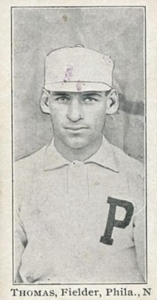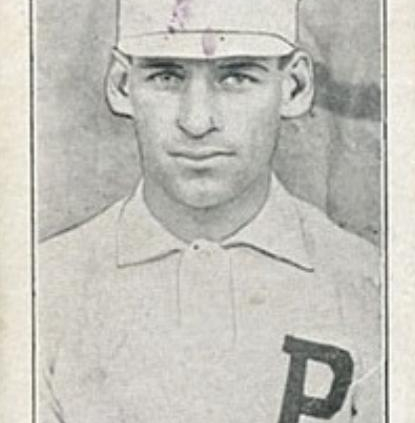Roy Thomas
 A slap hitter and exceptional bunter who specialized in fouling off pitches and drawing walks, Roy Thomas was an exemplary practitioner of “inside baseball,” but his skill package would have been useful to teams of any era. Playing mostly center field for his hometown Philadelphia Phillies, the left-handed hitter and thrower was nearly the equal of Phillies legends Billy Hamilton and Richie Ashburn both in ability to reach base as leadoff man and as guardian of the middle pasture. He ranks among the top players of all-time in ratio of walks to plate appearances, leading the National League in bases on balls in seven of his nine full major-league seasons. And on defense, Thomas led the loop’s outfielders in putouts three times, assists once, and total chances per game twice.
A slap hitter and exceptional bunter who specialized in fouling off pitches and drawing walks, Roy Thomas was an exemplary practitioner of “inside baseball,” but his skill package would have been useful to teams of any era. Playing mostly center field for his hometown Philadelphia Phillies, the left-handed hitter and thrower was nearly the equal of Phillies legends Billy Hamilton and Richie Ashburn both in ability to reach base as leadoff man and as guardian of the middle pasture. He ranks among the top players of all-time in ratio of walks to plate appearances, leading the National League in bases on balls in seven of his nine full major-league seasons. And on defense, Thomas led the loop’s outfielders in putouts three times, assists once, and total chances per game twice.
Roy Allen Thomas was born on March 24, 1874, in Norristown, Pennsylvania, a prosperous manufacturing town on the Schuykill River. Roy’s parents were primarily of Welsh descent. They raised him in a strict Christian household, and he continued to observe the Sabbath even as a professional ballplayer. (In 1904-05, for example, Phillies manager Hugh Duffy accumulated most of his playing time on Sundays while spelling Thomas.) Roy grew up in Sheetz’s Mill, just outside Norristown, and attended Norristown High School. After graduation he rode the nation’s first commuter railway to nearby Philadelphia, where he attended the University of Pennsylvania. A baseball standout for the Quakers, Thomas earned his bachelor’s degree from the Ivy League institution in 1894. He then played four years for the Orange Athletic Club, a semipro outfit whose roster included a number of former collegians. One of the club’s frequent opponents was the Honesdale Reds, which in 1898 included a high-school pitcher named Christy Mathewson.
Thomas broke into the National League in 1899 with a .325 batting average and career highs in games (150), runs (137), hits (178), walks (115), and on-base percentage (.457). Among his 178 hits must have been numerous bunt singles; though the exact number is unknown, contemporary observers estimated that he typically attempted 200 bunts a season. Because Thomas never sacrificed more than the 23 times he did as a rookie, we can assume that bunting for a hit was a major component of his offensive arsenal. At 5’11”, 145 lbs. during his playing days, Roy was long and lean for his era, especially for a player who drew so many walks. His secret was fouling off pitches, frequently turning a lengthy at-bat into a base on balls. Thomas is purported to have fouled off as many as 27 pitches in a single at-bat.
In his sophomore season, 1900, the pesky leadoff hitter batted .316, led the NL with 132 runs scored and 115 walks, and may have been responsible for launching a reform in baseball rules that helped create the game’s structure as we know it today. During one extended plate appearance that season he allegedly raised the ire of Brooklyn manager Ned Hanlon, a member of the NL’s rules committee. “Have your fun now, kid, because we’re going to take care of you for next year,” Hanlon yelled to Thomas in the batter’s box. Sure enough, in 1901 the NL adopted the foul-strike rule (counting the first two foul balls as strikes), apparently at Hanlon’s urging. “The purpose,” according to a contemporary report, “was to eliminate the growing tediousness of seeing batsmen deliberately foul off good balls in the hope of tiring the pitcher or getting a base on balls.”
The new rule barely had an impact on Thomas: he led the NL in walks for six out of the next seven seasons. In 1900 he averaged one walk drawn for every 4.6 at-bats; over the next three seasons his total rose only slightly to one walk per 4.7 at-bats, a drop of only about two percent. In contrast, the NL walk rate dropped by six percent over the same period, from one for every 12.9 at-bats in 1900 to one per 13.7 at-bats over the next three seasons. Thomas also maintained his batting average. From 1899 to 1905 he batted no lower than .290 (which, in 1904, was his only sub-.300 average in that stretch). Significantly, he fused his ability to reach base into baseball’s most crucial skill, scoring runs. Widely heralded as one of the NL’s best base runners, Roy scored at least 100 runs in four different seasons and stole 244 bases in his career.
That Thomas consistently batted around .300 in each of the first seven years of his career is amazing considering that he was a dead left-field hitter–and opposing teams knew it. Here’s what Chicago Cubs pitcher Ed Reulbach had to say about Roy Thomas:
“He not only hit almost all the time to left field, but he was a short-field hitter as well. This tendency handicapped him tremendously. With Thomas at bat, the left fielder moved close to the foul line and came well in. The center fielder shifted a way over toward left and at the same time advanced close up behind short and second. The third baseman moved over nearly to the foul line, and the shortstop followed him to a point at least 15 feet beyond his natural position. Thomas naturally realized the force of the conspiracy against him. But if he tried to pull the ball to the other field, the nearest he could come to that aim would be perhaps to loop it over the pitcher’s box. But the second baseman was also in the conspiracy. When shortstop moved over, second baseman followed, so that instead of being considerably to the right of second base, he was literally in line with the bag, so he was waiting ready for the ball if Thomas “pulled” it. The sole defense against against such a conspiracy is ability to hit hard. Thomas, however, unfortunately for him, did not possess this ability.”
Clearly Thomas was relying on his speed for most of his hits, so his precipitous decline at age 32 isn’t surprising. In 1906 his batting average plummeted 63 points to .254, and it sunk even further to .243 in 1907. Let go by the Phillies early in the 1908 season, Thomas batted .256 in 102 games for Pittsburgh that season and .263 in 82 games for Boston the next. He returned to the Phillies for a 1910 swan song in which he batted only .183 in 23 games, and in 1911 he capped off his playing career with a noble civic gesture that helped cement his place in Quaker City lore. With outfielders John Titus and Sherry Magee unavailable, Thomas temporarily came out of retirement to fill in for the team. He batted a mere .167 in his 21 appearances, but his two doubles raised his career total to 100.
With his playing days finally over, Thomas left behind one of the most unusual statistical resumes in baseball history. His career fielding percentage of .972 was a National League record at the time of his retirement. According to Bill James, Thomas was the only major-league regular to score three times as many runs as he drove in. He also had the lowest ratio of doubles to total hits of any big-league regular, the highest ratio of singles to total hits, the highest ratio of on-base percentage to slugging percentage (.413 to .333, or 1.24 to 1), the highest ratio of walks to extra base hits (6.5 to 1), and the fewest career RBIs for a player with 1,500 or more hits.
Off the field, Thomas was involved in several business interests. He became a part owner of a Philadelphia-area car dealership during his playing days, and he also worked for a morticians’ supply firm. For most of his post-playing career he worked for a Philadelphia-based coal company as a sales representative. Thomas never lost his passion for either baseball or his hometown. He coached the Penn baseball team in 1903, and resumed his duties there from 1909 to 1919, compiling a career record of 88-81-3. From 1928 to 1933 he coached at Haverford College, and between his collegiate stints he worked in the minors and semipro leagues of Philadelphia and New Jersey. Thomas maintained relationships with many of his former teammates, corresponding with players such as Elmer Flick to the end of his days. Throughout the 1940s and ’50s he was viewed in Philadelphia as a link to the city’s baseball heritage.
Roy Thomas died at the age 85 on November 20, 1959, at his home on the corner of Haws Avenue and Airy Street in Norristown, where he lived his entire adult life. Bessie, his wife of four decades, had preceded him in death a decade earlier, and he was living with his son, Roy Jr., one of four children. Philadelphians remembered Thomas as a gentleman who throughout his life was true to his family, his city, his Phillies, and his faith. Baseball historians remember him as a man whose batting tactics were in part responsible for changing baseball’s rules at the dawn of the Deadball Era.
Note: A slightly different version of this biography appeared in Tom Simon, ed., Deadball Stars of the National League (Washington, D.C.: Brassey’s, Inc., 2004).
Sources
For this biography, the author used a number of contemporary sources, especially those found in the subject’s file at the National Baseball Hall of Fame Library.
Full Name
Roy Allen Thomas
Born
March 24, 1874 at Norristown, PA (USA)
Died
November 20, 1959 at Norristown, PA (USA)
If you can help us improve this player’s biography, contact us.


